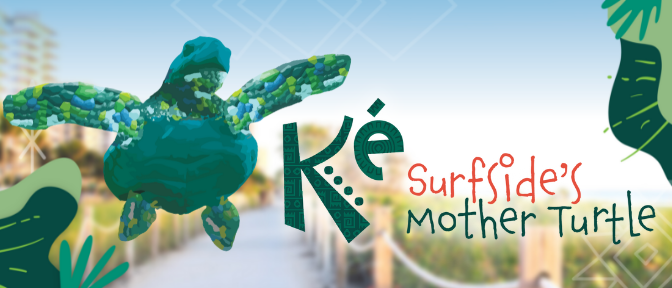
Surfside’s first inhabitants were the Tequesta. Their principal site on the Miami Beach barrier island in our region included a village (known by archaeologists as a midden) and a burial mound located on the shore of Indian Creek between present day 91st to 95th street.
To commemorate these remarkable historical findings and mark the start of Sea Turtle Nesting Season, the Town will soon be unveiling Ké, a curated new turtle sculpture, on the beach entrance at 95th Street later this month.
Ké, the middle syllable of the word Tekesta (Native American spelling), refers to planet Earth as turtles also represented “Grandmother Earth” in their cultures. Turtles were believed to dive deep down into rivers and oceans to find the solid materials that would eventually create land. This natural tie-in between the environment and Surfside's past inhabitants is the inspiration behind the this new public art initiative. The turtle sculpture, Ké, is a partnership with the Miami International University of Art + Design, whose student Ayalin Chaparro designed the artwork for the turtle, and the Historical & Archeological Conservancy.
Thanks to the Conservancy's research, led by longtime historian and Miami Circle Tequesta Expert Robert Carr, for the first time ever, we are able to learn new facts about the site discovered here almost a century ago!
SURFSIDE'S TEQUESTA HISTORY
The Tequesta fished, hunted and gathered native plants for food and shelter. Recovered marine animal bones from the Surfside site include fish, dolphins and other porpoises, sharks and even whales. Alligators and sea turtles were also abundant, as well as mammals, including Key deer. The age of some of the excavated artifacts indicates that the Tequesta lives in Surfside for as long as 2,000 years.
In 1923, the site was damaged by a new development laying out streets and residential lots (Altos del Mar). It was first excavated by State Archeologist Vernon Lamme in 1931 while subsequent excavations were led by the Smithsonian Institution. Recovered artifacts include pot sherds, shell tools, bone points, stone tools, and ornaments.
Numerous skeletons were found in the burial mound that included a mass grave of 19 skulls, but unfortunately, all of the human remains were stolen before they reached the museum. Their present whereabouts are still a mystery.
The Tequesta were destroyed as a culture after European contact in the 16th century. By 1763, the remaining population, victims of European introduced diseases and slave raids, fled to Cuba. Their vacated lands were then settled by the newly arrived Seminoles and Miccosukee.
Learn more about our very own "Mother Turtle" and Tequesta History.